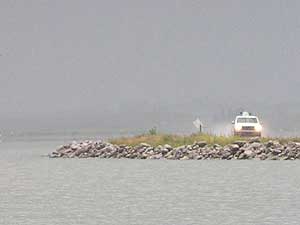|
Audio
Photos
|
July 18, 2005
 |
| Water from Devils Lake threatens Highway 281 near Minnewaukan, North Dakota. Plans are being made to relocate the highway. (MPR Photo/Bob Reha) |
Devils Lake, N.D. — Devils Lake has doubled in size since 1993. the water now covers more than 170 square miles.
Other than evaporation, there is no way for water to leave the lake. For the past 12 years, the drainage area feeding the lake, has been in a wet cycle, causing the water to rise.
If there's one thing the Devils Lake region doesn't need, it's more rain. The operation of the outlet was scheduled to begin July 1, but wet weather delayed the startup.
Bruce Engelhardt is the project manager for the Devils Lake outlet. The rain pounds his pickup truck during a recent tour of the work sites on the outlet.
Engelhardt explains how it'll work. Water will be pumped out of the lake over a 14-mile stretch of land, to the Sheyenne River. The water will flow through a series of open canals and pipes.
Engelhardt says he doesn't have time to focus on the lawsuit.
"My job is to get the outlet built and operating, and that's what I'll continue to try and do," says Engelhardt.
Citing the International Boundary Waters treaty, Canadian opponents fear water from the project will damage Canada's fisheries and water quality. They want the outlet stopped, until those issues are resolved.
This isn't the first time the outlet has been challenged in court. An earlier lawsuit questioned whether the North Dakota Health Department broke the law in issuing a permit for the outlet project. The state's Supreme Court ruled that proper procedure was followed.
Engelhardt says the outlet permit has several restrictions, which are intended to reduce the possibility of downstream flooding along the Sheyenne.
Engelhardt says the state may only pump water from May through November, and must stop when the lake recedes to 1,445 feet above sea level. Last week, the lake was measured at 1,449 feet above sea level.
"The outlet by itself isn't going to solve the flooding problem by any means," says Engelhardt. "Really, the purpose of the outlet is to reduce the future rate of rise at Devils Lake."
Engelhardt says although the outlet isn't the only solution to the flood problem, more delays will only make things worse.
Dick Betting is a member of a citizens group, People to Save the Sheyenne, which lost a legal challenge to stop the project. Betting lives about 100 miles downstream from the outlet. His home sits on a hill above the Sheyenne River.
The retired English professor is concerned about water quality. The water to be pumped out of the west bay of Devils Lake has a higher salt content than the Sheyenne river.
"But they get around that by saying, 'Well, by the time it's in the Sheyenne it would be blended, so it won't be too bad,'" he says. "So what they're actually saying is the Sheyenne River water is better than west bay water, and it will make the bad west bay water acceptable."
Betting also says no studies have been done to determine what effect the water from the lake will have on the river's fish.
As the waters of Devils Lake have risen over the years, homes were relocated, dikes were built and highways were reconstructed. That battle has been expensive -- the price tag so far is $500 million.
The Devils Lake problem has been an obsession for Joe Belford, county commissioner in Ramsey County, N.D. For the last 12 years he's worked constantly, trying to find some way to relieve the situation.
Belford won't speculate about what may happen in Canada's courts. But he is encouraged that previous court decisions upheld the outlet's permit. He believes the proper tools are in place to protect downstream concerns.
"Our state permit is very good, very strong," Belford says. "We're going to put 10 monitoring points in the Sheyenne and Red River, and anyone can go on to the Internet at anytime and see what's going there with salt and sulfates."
Despite the looming court challenge, work continues on the outlet. North Dakota officials hope water will move through the outlet by the end of July.
But in Canada, opponents are preparing legal arguments they hope will allow the federal courts of Canada to intervene.






